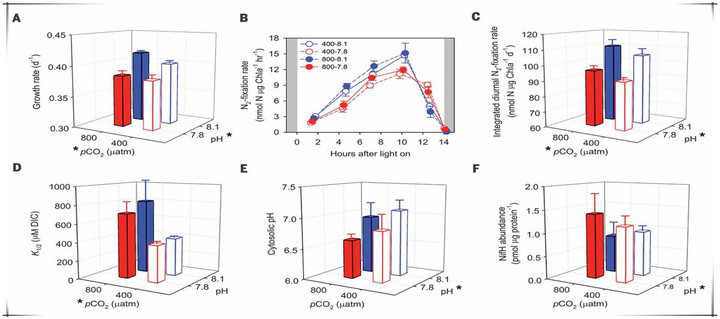
On April 27, 2017, a Science paper entitled “The complex effects of ocean acidification on the prominent N2-fixing cyanobacterium Trichodesmium” was published online ahead of print. This work is attributed to the research team led by Prof. Shi Dalin from the College of the Environment and Ecology, XMU.
Based on many recent laboratory and field experiments, this research directed its attention to the trichodesmium, a major contributor of “new nitrogen”, and found that growth and N2-fixation of the ubiquitous cyanobacterium Trichodesmium decreased under acidified conditions, notwithstanding a beneficial effect of high CO2. Acidification resulted in low cytosolic pH and reduced N2-fixation rates despite elevated nitrogenase concentrations. Low cytosolic pH required increased proton pumping across the thylakoid membrane and elevated adenosine triphosphate production. These requirements were not satisfied under field or experimental iron-limiting conditions, which greatly amplified the negative effect of acidification.
The study not only revealed the influence and mechanism of acidification on trichodesmium, but also offered a scientific explanation to the paradoxical opinions about this question worldwide, and it is of major significance to a deeper understanding of marine biogeochemical cycles of carbon and nitrogen under global change.
Prof. Shi Dalin is the correspondence author of this paper, Asso. Prof. Hong Haizheng the first author. Meanwhile, this study also owes much to the core members on the research team including research assistant Shen Rong, doctoral students Zhang Futing and Wen Zuozhu as well as the scientists from State Key Levorotary of Marine Environmental Science (MEL), Florida State University and Princeton University. Among other things, the research has been supported and funded by the “Thousand Youth Talents Program”, the ”Outstanding Youth Science Fund” and general programs of NFSC, the national key R&D plan and etc.
link:http://science.sciencemag.org/content/early/2017/04/26/science.aal2981
Edited by Meng Ling & Guo Yanyan
Source: http://news.xmu.edu.cn/3a/a8/c1550a277160/page.htm
